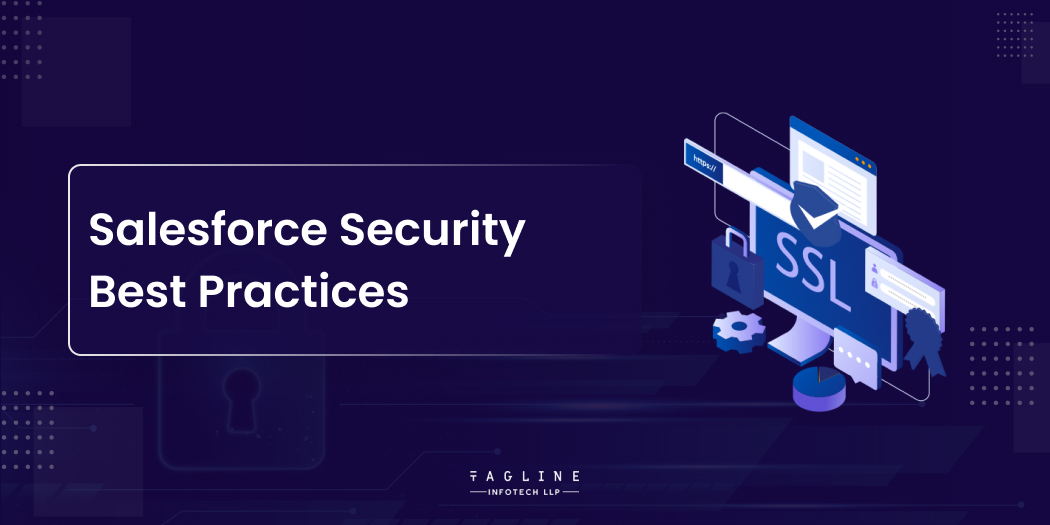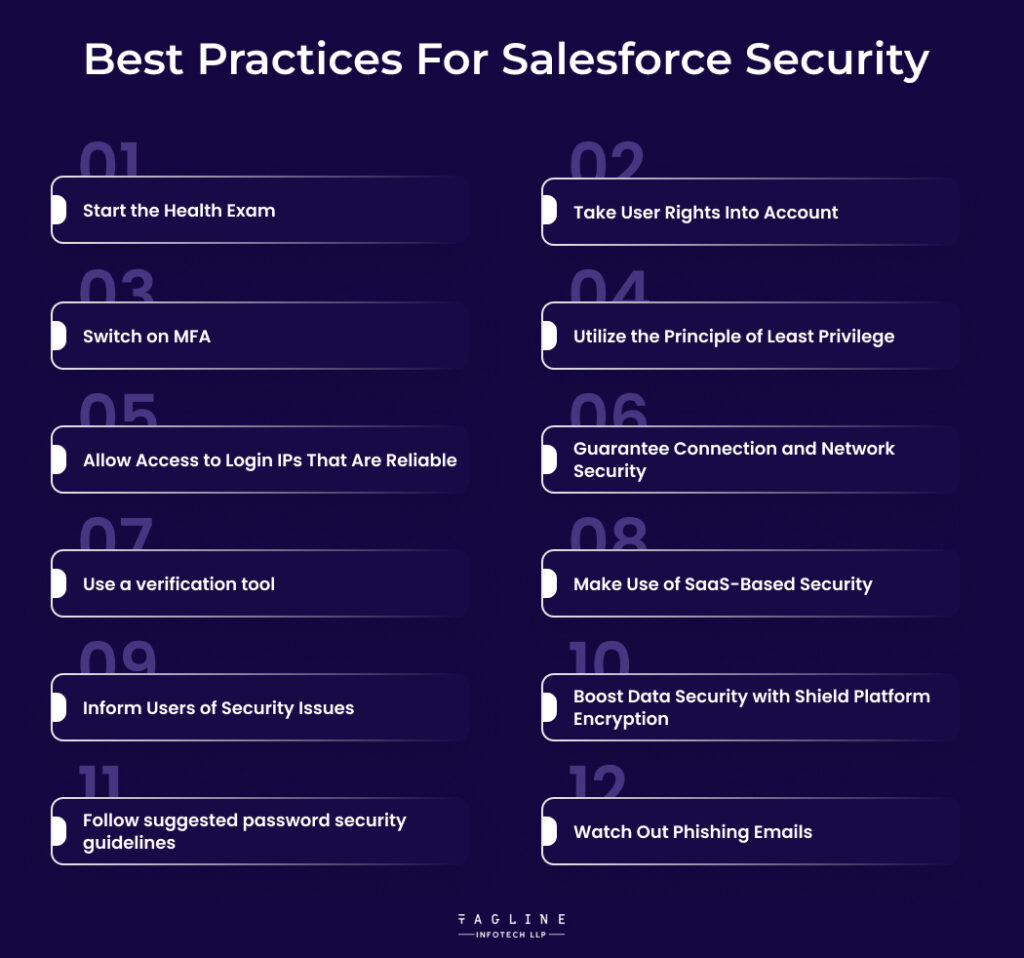What is Scalability in Cloud Computing? Types, Benefits,...
April 24, 2024
Home >> Salesforce >> Best Practices For Salesforce Security

Quick Summary
Salesforce leads all four competitors combined in the CRM market share, with a staggering 19.8% market share. Its enormous coverage and dependability are highlighted by its widespread use, although security remains a critical concern. Businesses run the danger of having a SaaS data breach that costs, on average, more than $28 million. Like every other SaaS application, Salesforce is one. Most cloud and SaaS services operate under the shared responsibility model. In other words, you have some responsibility, and the vendor handles the rest regarding the security of your account and data. The 12 essential Salesforce security steps that are necessary to safeguard sensitive information and your Salesforce account from internet attacks will be guided through in this lesson.

With the Health Check tool, managers have an additional and comprehensive method to evaluate and enhance the security configurations in their organization, particularly in the context of Salesforce Implementation steps. This tool is embedded into the core architecture of Salesforce.
This vital application allows administrators to find and offer patches for any discovered security problems and develop and manage personalized baseline standards, specifically tailored for Salesforce Implementation. This ensures that security protocols are tailored to and aligned with specific business requirements. Organizations can use Health Check to ensure their Salesforce instance complies with best practices and resists potential security threats.
With permission sets in your Salesforce configuration, you can control who can do what. Acknowledge the primary duties and tasks that your users complete. In light of this, create the necessary permission sets. Delete any rights that are not legitimate. If a user asks for those permissions, you can use permission sets to grant them. Everyone can continue to do their jobs and keep things secure.
Multi-factor authentication (MFA) is an additional layer of security that protects against common threats like phishing attempts, credential stuffing, and unwanted account access. Companies that employ MFA significantly bolster the security protocols that protect their Salesforce data. In addition to being a recommended best practice, this enhancement may be the most crucial thing a company can do to safeguard its digital assets and the integrity of its Salesforce data against potential attacks.
The principle of least privilege dictates that users should only be granted the access necessary to carry out their duties. Restricting access is a safer option than granting everyone full access. Someone should only be able to view data; they shouldn’t be able to change it. This lessens the risk. If someone’s account is compromised, they are limited in what damage they can do. It’s a simple yet efficient method to keep your Salesforce configuration secure.
One wise method to safeguard your data is restricting access to your Salesforce database based on IP address. Administrators can designate “safe” IP ranges. This suggests that we will only accept logins from these trustworthy IP addresses. An untrusted IP address will result in either blocking or a request for identity when someone tries to log in. This guards against illegal access and phishing.
To protect your Salesforce data, you must have a secure internet connection. Regularly connecting to a VPN is a great way to boost security. Take some time to change the router’s configuration as well. Ensure the firmware is current and enable encryption (preferably WPA2 or WPA3). This helps keep outside devices out of your network and shields your data from prying eyes.
Another suggested practice for Salesforce security is to use the Salesforce Authenticator. It’s a straightforward two-factor authentication method that adds another layer of protection. Consumers merely need to tap on their mobile devices to accept logins and actions. Additionally, it can automatically recognize and verify logins from secure places. If you’d like, you can also choose third-party substitutes like Google Authenticators or Microsoft Authenticators. The main goal is to make security easy and effective for everyone.
It is crucial to take security safeguards because of the increasing reliance on SaaS technologies like Salesforce. By integrating a SaaS security tool, businesses can effectively manage privileges across all SaaS products used in their organization, including Salesforce, and monitor potential vulnerabilities. Any suspicious activities or anomalies in your Salesforce environment are promptly brought to light by these technologies.
Staff education is an essential first step in securing your Salesforce data. Customers can get around even the most robust security measures if they need to be aware of potential risks. Regular training sessions will help your team spot threats like emails or strange login requests. By updating people on the latest security protocols and possible threats, you empower them to act as the first defence against cyberattacks. Remember that a team with knowledge is a safer team.
Salesforce Shield is a collection of enhanced security technologies designed specifically for Salesforce. Its goal is to ensure that businesses can consistently trust, administer, and adhere to their essential apps. Shield Platform Encryption stands out in this package since it offers the best data protection.
Unlike standard encryption, which only safeguards data during transmission, Shield Platform Encryption secures your data while it is stored or at rest. This ensures that businesses manage sensitive information in compliance with the stringent regulations set forth by privacy policies, governmental bodies, and contract provisions.
Salesforce Shield provides Platform Encryption along with Field Audit Trail and Event Monitoring. Together, these tools create a solid basis for security. If you’re considering using Salesforce Shield, ask your administrator if your organization can use it.
A password is frequently the initial layer of protection against unauthorized access. Please make sure they are solid and challenging to decipher. Encourage users to use unique passwords for Salesforce and avoid using easily known passwords like “password123” or their birthdates.
Passwords can be safer by using a mix of letters, numbers, and symbols, changing passwords often, and preventing recurrence on many platforms. Additionally, sharing or writing down passwords in public areas is not advised. Following these few recommendations can significantly reduce unauthorized access.
Phishing is a clever tactic used by con artists to send bogus emails and trick victims into divulging personal information. These phoney emails may seem from reputable sources, but they usually contain hidden agendas. Individuals who click on links or download attachments in these emails may inadvertently install dangerous software that gathers personal data.
Always proceed cautiously and thoroughly review any unexpected or questionable emails. It is advisable to consult your IT team or security experts and refrain from doing anything that doesn’t feel correct.
Salesforce offers extensive security features designed to safeguard your information and improve user experience. Here’s a summary:
Salesforce uses modern technology to ensure internet security. Transport Layer Security (TLS) technology protects your information using browsers that Salesforce supports. This ensures that only authorized personnel within your organization can access and maintain data integrity.
You can shield users from risky links by controlling what happens when they click on them and redirecting them outside the Salesforce domain.
A few choices are available:
Data protection is the top-most priority to make your business successful. Follow these best practices for Salesforce security so that you can be in a better position compared to others in terms of security and reliability. In conclusion, implement these practices for the growth of your business because Salesforce allows you to have full control over the system. Connect with our tagline infotech developer team to ensure seamless integration and optimization of these security measures.
Salesforce might adopt a best practice for passwords by enforcing a complex password policy that requires the usage of capital and lowercase letters, digits, and special characters in addition to periodic reset requirements.

Digital Valley, 423, Apple Square, beside Lajamni Chowk, Mota Varachha, Surat, Gujarat 394101
+91 9913 808 2851133 Sampley Ln Leander, Texas, 78641
52 Godalming Avenue, wallington, London - SM6 8NW